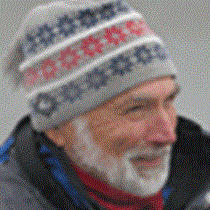Isla Carmen, Baja California
We awoke with no clue of the marine mammal adventures that lay ahead. Although bottlenose dolphins were close by, we took advantage of three fin whales near the ship. We had wonderful views of these sleek and muscular greyhounds of the sea. Eight minutes was not a long time to wait until they returned to the surface after feeding on krill. We also watched Thurston’s devil rays that were cruising in the area.
The sea was so calm that at times we could see the surface vibrate with boiling activity from the fins of thousands of shoaling fish pushed up by the threat of predators. The black shape of a Bryde’s whale broke the surface and was soon in the midst of another area of shimmering water. We passed more fin whales later in the morning and then entered a group of bottlenose dolphins. Some seemed to race along in small groups, while others leaped high out of the water and smacked the surface as they reentered with belly flops. They may have been foraging by using the percussion of their bodies against the water to frighten fish into compact masses, or perhaps it was for the pure joy of being able to jump through the air. The young calf in the photograph was porpoising out of the water right along with its mom. This bond of close proximity lasts for several years in bottlenose dolphins.
After lunch our ship anchored in the protected waters of Balandra Bay on the north side of Isla Carmen. We launched our kayaks in this pristine and colorful place and glided by places where sailing ships once anchored to load and transport salt to the missions in Loreto and other areas of the gulf. Salt was also carried across the island by donkeys, and today hikers made their way along this route up a canyon lined with palo blanco, palo verde, and mesquite trees.
Five minutes after pulling our anchor, we were in the midst of false killer whales. There were about 20 including a few very small calves. We followed them for 15 minutes and then saw about 100 bottlenose dolphins close by. The activity of these two species didn’t seem to affect each other in any way. The dolphins were either mostly underwater or at the surface, racing dramatically in a frothing mass. They then went back to diving and milling, soon to be racing in the other direction, presumably chasing fish. Darkness closed in, and our ship turned north for tomorrow’s adventures.
We awoke with no clue of the marine mammal adventures that lay ahead. Although bottlenose dolphins were close by, we took advantage of three fin whales near the ship. We had wonderful views of these sleek and muscular greyhounds of the sea. Eight minutes was not a long time to wait until they returned to the surface after feeding on krill. We also watched Thurston’s devil rays that were cruising in the area.
The sea was so calm that at times we could see the surface vibrate with boiling activity from the fins of thousands of shoaling fish pushed up by the threat of predators. The black shape of a Bryde’s whale broke the surface and was soon in the midst of another area of shimmering water. We passed more fin whales later in the morning and then entered a group of bottlenose dolphins. Some seemed to race along in small groups, while others leaped high out of the water and smacked the surface as they reentered with belly flops. They may have been foraging by using the percussion of their bodies against the water to frighten fish into compact masses, or perhaps it was for the pure joy of being able to jump through the air. The young calf in the photograph was porpoising out of the water right along with its mom. This bond of close proximity lasts for several years in bottlenose dolphins.
After lunch our ship anchored in the protected waters of Balandra Bay on the north side of Isla Carmen. We launched our kayaks in this pristine and colorful place and glided by places where sailing ships once anchored to load and transport salt to the missions in Loreto and other areas of the gulf. Salt was also carried across the island by donkeys, and today hikers made their way along this route up a canyon lined with palo blanco, palo verde, and mesquite trees.
Five minutes after pulling our anchor, we were in the midst of false killer whales. There were about 20 including a few very small calves. We followed them for 15 minutes and then saw about 100 bottlenose dolphins close by. The activity of these two species didn’t seem to affect each other in any way. The dolphins were either mostly underwater or at the surface, racing dramatically in a frothing mass. They then went back to diving and milling, soon to be racing in the other direction, presumably chasing fish. Darkness closed in, and our ship turned north for tomorrow’s adventures.




